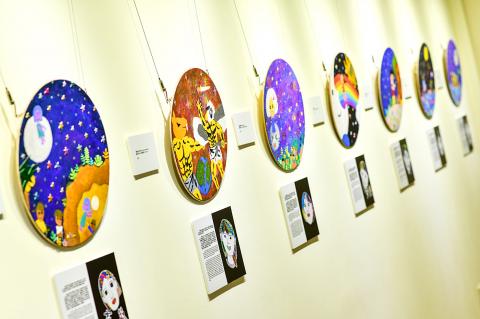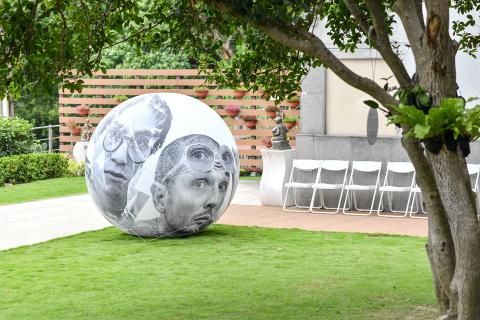Cross-cultural differences, similarities and post-colonial identities are explored through contemporary art in an exhibition put together by Taipei National University of The Arts (TNUA, 國立臺北藝術大學) graduate students, now at the Beitou Public Assembly Hall.
The student curators of “Difference & Identity: Contemporary Cross-Cultural Encounter through Arts” are either enrolled in the international masters’ program in cultural and creative industries and/or at the Graduate Institute of Fine Arts. They have put together the show as part of the work they did for an art exhibition class taught by Chang I-wen (張懿文) and one on intercultural communication taught by Randy Finch.
The artworks are by students at four local elementary or junior-high schools that are partner schools with the “University Social Responsibility” project, which is led by associate professor Lin Ya-tin (林亞婷), as well as established Taiwanese and foreign artists.

Photo courtesy of Anpis Wang
The works range from paintings, photographs and sculptures, to videos and sound installations. The exhibit is divided into three sections, each with a different theme and style.
The focus of the “The Moon” pieces is the common elements found in different cultural mythologies, and features moon-shaped works by elementary and junior-high schools students.
“I Belong: Questions of Identity” and “chaque personne est la seule limite a leur propre identite” (each person is the only limit to their own identity) themed works include pieces by contemporary artists, including Taiwanese multi-media artist Chen Shu-chen (陳淑貞), who has won several national photography and multi-media awards.

Photo courtesy of Anpis Wang
Chen will give a talk about her work and a tour of her “Interracial Marriage Family Portrait” series that is part of the exhibition tomorrow afternoon.
■ “Difference & Identity: Contemporary Cross-Cultural Encounter through Arts,” at Beitou Public Assembly Hall (北投公民會館), 5-7, Zhongshan Rd, Taipei City (台北市中山路5之7號)
■ The exhibition is open through Sunday from 9am to 5pm daily. Admission is free
■ The artist talk and gallery tour by Chen Shu-chen is from 2pm to 4pm tomorrow

That US assistance was a model for Taiwan’s spectacular development success was early recognized by policymakers and analysts. In a report to the US Congress for the fiscal year 1962, former President John F. Kennedy noted Taiwan’s “rapid economic growth,” was “producing a substantial net gain in living.” Kennedy had a stake in Taiwan’s achievements and the US’ official development assistance (ODA) in general: In September 1961, his entreaty to make the 1960s a “decade of development,” and an accompanying proposal for dedicated legislation to this end, had been formalized by congressional passage of the Foreign Assistance Act. Two

Despite the intense sunshine, we were hardly breaking a sweat as we cruised along the flat, dedicated bike lane, well protected from the heat by a canopy of trees. The electric assist on the bikes likely made a difference, too. Far removed from the bustle and noise of the Taichung traffic, we admired the serene rural scenery, making our way over rivers, alongside rice paddies and through pear orchards. Our route for the day covered two bike paths that connect in Fengyuan District (豐原) and are best done together. The Hou-Feng Bike Path (后豐鐵馬道) runs southward from Houli District (后里) while the

March 31 to April 6 On May 13, 1950, National Taiwan University Hospital otolaryngologist Su You-peng (蘇友鵬) was summoned to the director’s office. He thought someone had complained about him practicing the violin at night, but when he entered the room, he knew something was terribly wrong. He saw several burly men who appeared to be government secret agents, and three other resident doctors: internist Hsu Chiang (許強), dermatologist Hu Pao-chen (胡寶珍) and ophthalmologist Hu Hsin-lin (胡鑫麟). They were handcuffed, herded onto two jeeps and taken to the Secrecy Bureau (保密局) for questioning. Su was still in his doctor’s robes at

Mirror mirror on the wall, what’s the fairest Disney live-action remake of them all? Wait, mirror. Hold on a second. Maybe choosing from the likes of Alice in Wonderland (2010), Mulan (2020) and The Lion King (2019) isn’t such a good idea. Mirror, on second thought, what’s on Netflix? Even the most devoted fans would have to acknowledge that these have not been the most illustrious illustrations of Disney magic. At their best (Pete’s Dragon? Cinderella?) they breathe life into old classics that could use a little updating. At their worst, well, blue Will Smith. Given the rapacious rate of remakes in modern